#MGS2 spoilers
Text

Flirting vs. Harassment in MGS2
516 notes
·
View notes
Text

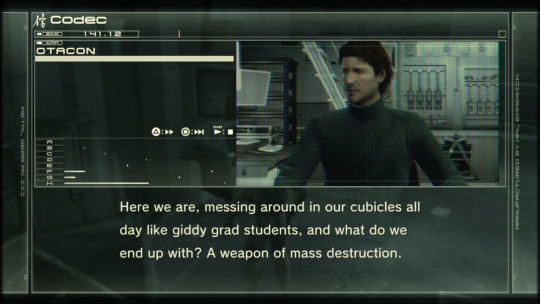

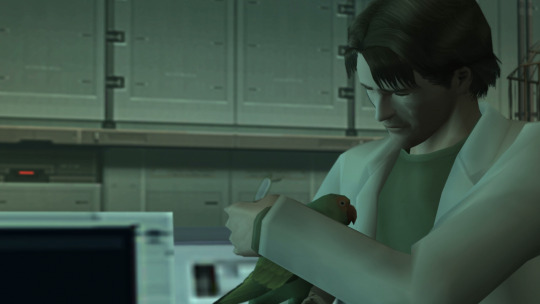




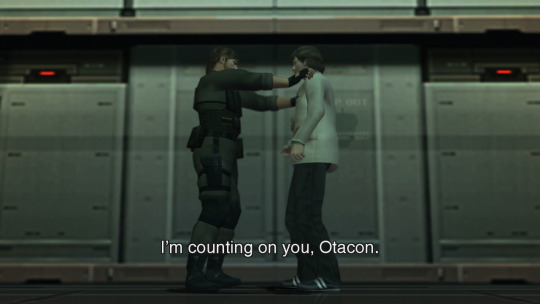



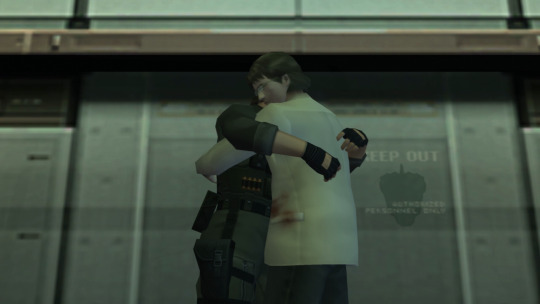

Otacon: You mean I'd only get in your way... (Feeling bitter about his helplessness)
Snake: Wrong. Only you can save those hostages. Got it?
Gripping Otacon by the shoulders, Snake reassures him. Smiling, Otacon nods his head.
#otasune#solid snake#otacon#hal emmerich#mgs2#mgs4#They make me. Insane.#mgs#metal gear solid#ada's screencaps#ada speaks#caption is from the script found in the document of metal gear solid 2#i NEEDED to compare these ok. it was making me fucking crazy#mgs2 spoilers#snake. giving otacon a Directive every time he notices him getting upset. because... that's how snake gets through life.#'that's your job right? to support me?' snake. i know you know what youre doing.#both times. he reassures otacon by affirming his importance to him#stresses that he cannot go on without his help and support#and it goes both ways#otacon gives snake purpose too#in the novel otacon says that snake has a 'tragic sense of responsibility' for raiden and meryl. but he suspects also extends to him#and it does#but despite everything... he chooses to carry this weight. he is directionless without a purpose#this is how snake keeps going#its why he took on responsibility for 50 huskies in alaska#its why he took it upon himself to make sure meryl got out of shadow moses alive 'for himself' and not for campbell#its why he joins otacon in atoning for their sins via philanthropy#and in these moments he reminds otacon that they have a job to do not because he is insensitive or uncaring#but because he himself functions this way. you can't change the past. but you can make a better future.
681 notes
·
View notes
Text










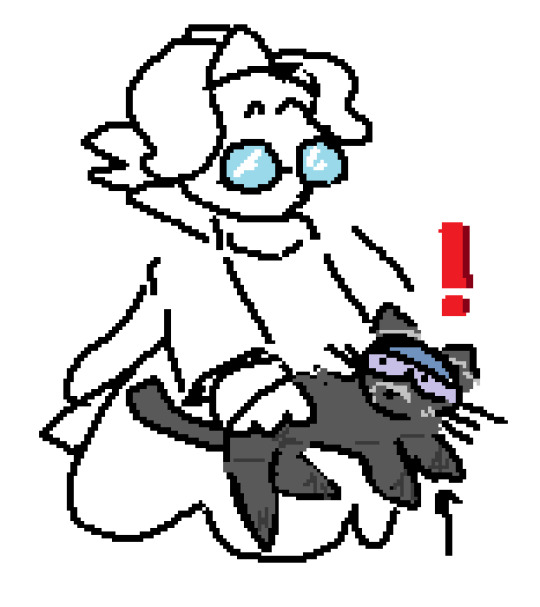
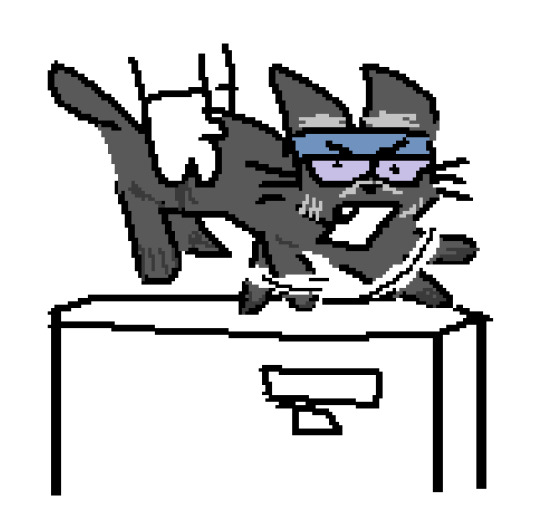


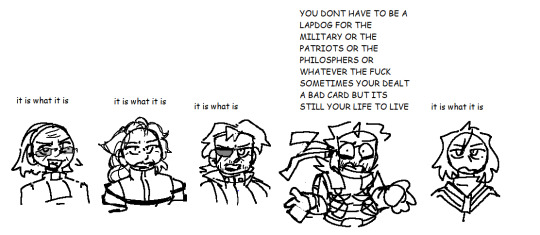


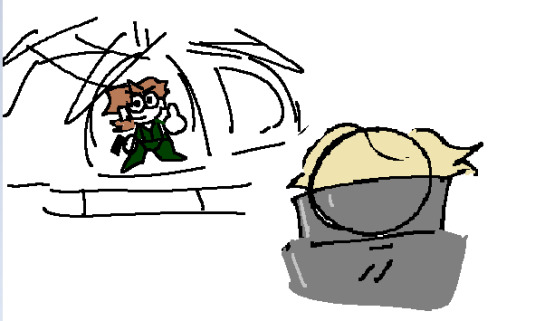




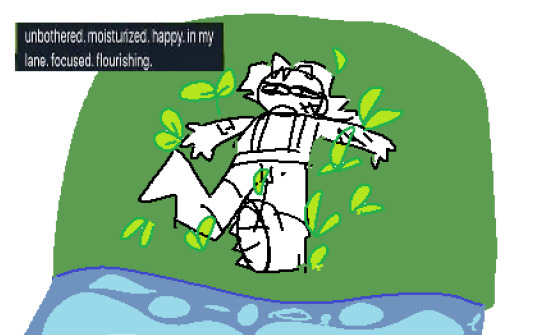



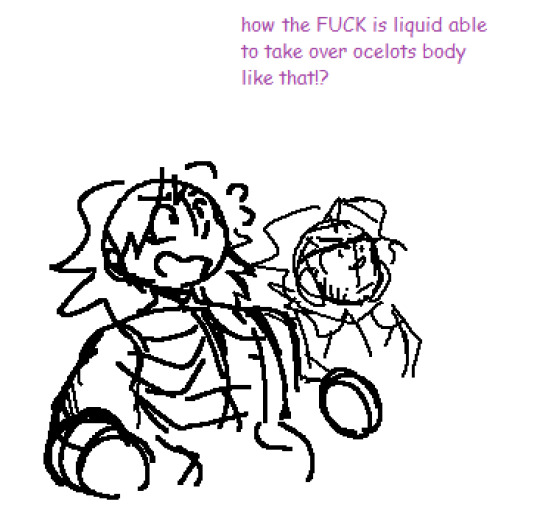


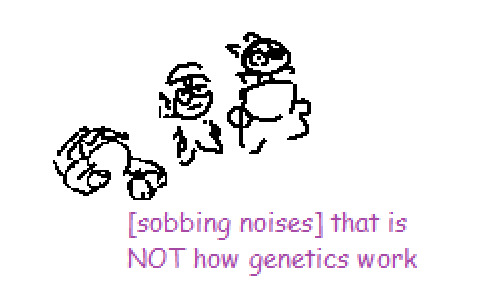
[ID in ALT]
collection of metal gear solid drawings as i went through the series. if you see something here that isnt wrong know its bc it was revealed after i drew the silly doodle
#ashenart#mgs spoilers#mgs2 spoilers#mgs3 spoilers#mgs4 spoilers#LIKE YES. NOW I KNOW OCELOT GAVE HIMSELF A LIQUID FICTIVE. i didnt know that during mgs2#i just assumed genetics bc thats all liquid goes on about YEESH#anways. enjoy#Metal gear solid
37 notes
·
View notes
Text
Funfact: In MGS2 after you kill Solidus, you can see him saying something before falling, but since the game's audio stops at that point, you never get to hear what he says. His entire goal was to be remembered, and yet even his last words were censored and taken away from him. Also I saw a youtube comment theorizing that he was saying "I'm proud of you Jack" and I like that headcanon.
69 notes
·
View notes
Text
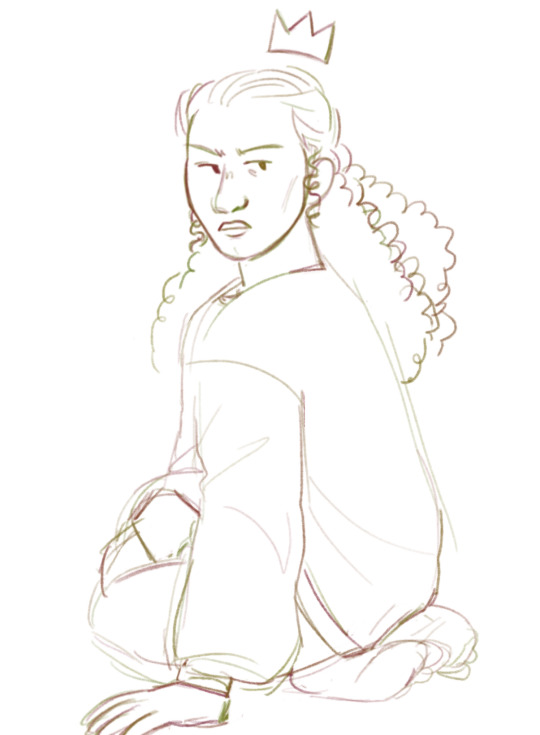
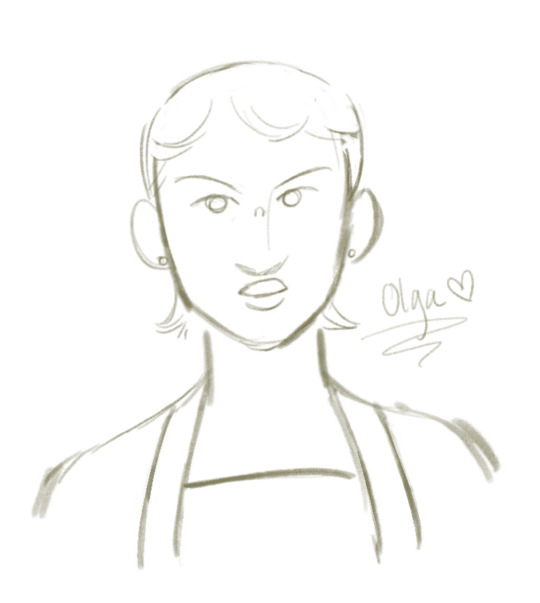
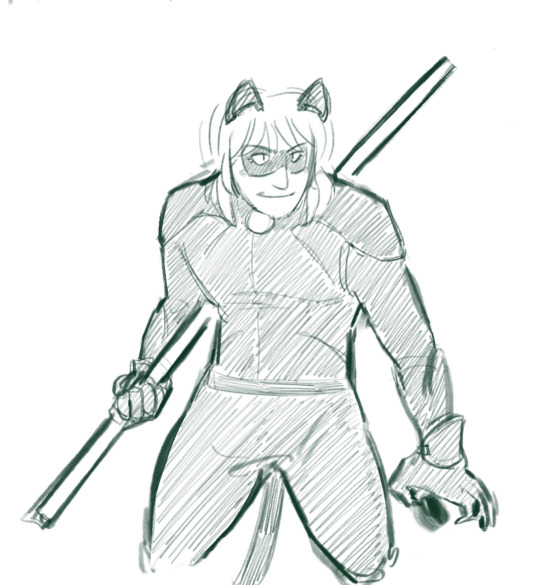

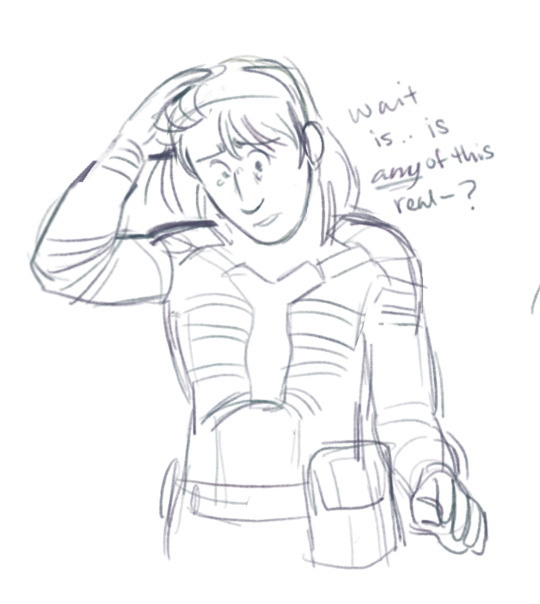
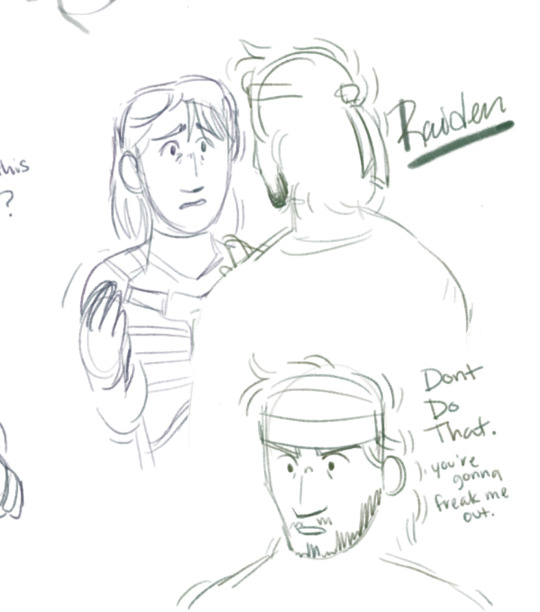
Played mgs2 for the first time the other day (courtesy of @mochpit ) and here were some doodles I did while I played!
(I’m playin mgs3 rn so be prepared for a couple memes next)
#mgs#mgs2#mgs2 sons of liberty#metal gear raiden#raiden fanart#mgs2 raiden#mgs2 spoilers#mgs2 fortune#mgs2 Olga#iroquois pliskin#solid snake#Raiden dressed up as chat noir#<3#unreality#disassociating??#the end of mgs2 was really weird#but I honestly loved it
66 notes
·
View notes
Text
Metal gear mania days 1&2
Game: MGS2
Got started yesterday and cleared the tanker and got past the basic setup of the main game. I’ve played Twin snakes a lot back in the day so I was vvaery familiar with the controls and was able to slide back into that control scheme very easily in MGS2 save for a little trouble converting muscle memory from a game cube controller to a ps3 controller. If you’ve played either you know how good this scheme feels, responsive movement leaning around corners and first person aiming combined with the lovely shoulder button menus makes this a great experience from a gameplay standpoint I’d imagine that at launch the tanker segment was a very engaging playground for learning and testing the new controls while it my case and Im sure others who started with the twin snakes it worked as something of a check list like a pre flight check to makes everything was up and running. The tanker also does very well at setting up plot hooks and intrigue some of which went very different directions than I thought they would as always it makes me happy to hear Snake and Otacon.
(Spoilers below the cut)
I was also happily surprised to hear cam Clarke back at it as liquid snake in the form of an arm ocelot picks up being the funniest guy ever right where he left off after the post credits of twin snakes immediately showing up acting goofy doing gun tricks and turning on his allies before succumbing to the horrible fate of being British even if just for a moment. I don’t have much to say on the shift to Raiden as it was something i knew would happen, hard to keep stuff like that under wraps these days. Something I really did appreciate was just how hard this game attempts to gaslight you into thinking everything’s hunkey dory from raidens initial codename being Snake or Campbell, who I’ll talk more about in a bit repeating the lines about the Soloton radar from the first game, not much to say naritively about the early game as most of the conversation where about using the action button is various wacky ways. The main thing that happened during the first day was mostly me trying to wrap my head around why people seemed to hat raiden so much when this game came out. This guy is hilarious and frankly pretty adorable. One of my favorite things about the first game is how it makes you the player and solid snake the character feel like this expendable grunt even while doing insane shit like rocket jumping to kill a helicopter, something I haven’t seen talked about a lot is just how much of the game is something of mystery story and you ALWAYS feel like your the last to know and that Carries over to this game. At this point my naritive thoughts are gonna blend days 1 and 2 together and I’m not gonna really section things out super hard between them, I think a strength of this game is how that sense of being left in dark carries over but is fundamentally different due to having played the last game. At the beginning of MGS there’s no real hint that this is going to be more complex than it presents itself to you. The vibe early on is one of a cool action game where you go in and do snakes solider man things maybe this is different if you played the OG metal gear but for me I was unaware and that feels intentional by the time you get to the DARPA chief you start unraveling these threads and dont really stop untill the end of the game. MGS2 starts you the player and Raiden at about the same point in terms of knowledge with one key difference. You the player KNOW what really happened on Shadow Moses and raiden does not you start the game knowing that something isn’t right and there are these crossing wires but even after all you did in MGS 1 you still dont know enough. I think having the two man booth really adds to this and Campbell repeating lines from the first game weaves that beautifully to give you the sense that something isn’t quite right before you even really start the story. Those lines put you in the headspace of MGS with this full support team but here at this point you really only have the colonel and Rosemary, who I really like i think her dynamic with Raiden is cute. On the other hand Campbell feels off. I love Paul riding hearing is voice makes me feel as though I’ve consumed a lovely warm stew in an otherwise frigid winter is that warmth that spreads through out your body. I do not feel that here at all. I know he kept secrets in MGS and was pretty shady at the end (though the specifics escape me and I was too spoiler scared to check a wiki) but this feels like a whole different level At the point I’m currently at so much of the initial details have been showned to be incomplete or flat out untrue not to mention aspects of the situation he doesn’t include. The combination of his insistence that you can’t trust pliskin ( who IS solid snake I’m not gonna bother with the bit here even though its really funny) and the at times very aggressive tone with which he interacts with raiden makes it really hard to tell if this is stuff he genuinely doesn’t know or if he knows way more than hell let in on. This is another thing i think works really well in conjunction with the first game.\
In that game Campbell was a solid grounding presence which was used by the game later when even he starts becoming unsure and untrustworthy just how much you don’t know and how little of a grasp is had by the cast on the reality of the situation at shadow Moses. In MGS2 you are armed with that knowledge but are still presented with Campbell as the grounded athoritiative figure this creates a sensation of unsteady ground to the player immediately while providing a lot more incentive to interact with and trust pliskin aside form the fact he’s obviously snake he feels like hes got more of the situation figured out and is much more willing to tell Raiden. Side note these feelings of uncertainty and distrust are defiantly also influenced and reinforced by the tanker incident but I find myself unable to articulate that to the degree I could with stuff from the first game.
The Game is also paced very well even if you’re playing it like a nutcase like I am as you go through more and more of things you were told about the mission prove to just be untrue beyond just its more complicated than we initially thought, like i said I’m not sure if Campbell is traight up lying to me or not but at the point I’m at now I’ve just learned about the patriots and its hard not to notice how much the plan of action Campbell insist upon lines up with what it seems they would want at this time I can’t be sure if cause he works for the military of hes just being fed just the same bad info we are or if theres more to it but I am intrigued
On a final note the antagonist situation is interesting. Dead Cell are, objectively, hilarious. I lost my mind when Fatman in particular roller bladed up with his bomb disposal gear and wine glass to talk about how epic his next YouTube prank was gonna be, Vamp just does increasingly more ridiculous things every time hes on screen, Fortune is cool as fuck and her theme fucking melts. After that it does get a bit confusing as which out of the three between ocelot the patriots and solidus i should focus on and I think that’s intentional. It does feel like being in a room with three people where on of which is going to kill you and the others but you don’t if its going to be all of them or just one and if so which one. It all adds up to give a sense that you can’t stay still or in one place too long you have to keep pace with something to stay alive but figuring out exactly what or who is anything but easy
In conclusion: four stars check it out.
2 notes
·
View notes
Photo

I’ve reached the part which practically emptied me. If you know - you know. I feel sad for Raiden (also Emma and Otakon part is just too dark). It hit me too hard and I need a break. Also...As I am getting even deeper into the mgs lore, my fanfic will get more value with things about Raiden. Why...Why has he go through all of this? Poor baby boy, I wish Sam was there to help ;_;
Anyways, I may have some depressed thoughts and feelings for quite a while, so...I would ask for support in any form.
16 notes
·
View notes
Text
Who would win in a fight, Metal Gear Solid 2: Sons of Liberty, or Danganronpa V3: Killing Harmony?
Anyone who's played both games will know why I ask.
0 notes
Text

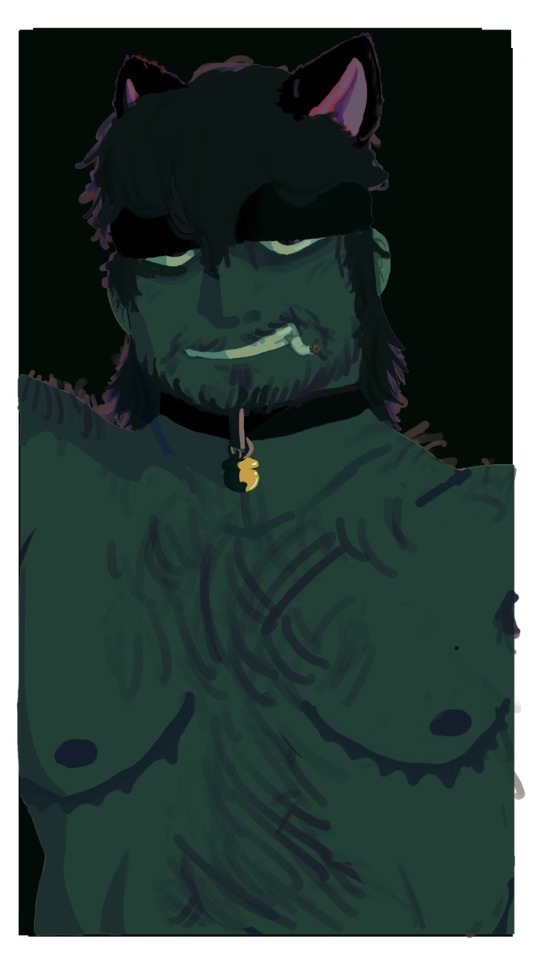


when the snake is solid‼️
#my condolences to the people who followed me for lupin#i’m still so full of lupin love but i have mgs brainworms rn#i went into mgs convinced otacon was gonna be my fav but i was oh so wrong. i spednd the whole time playing mgs2 going hi snake. hi beautif#when i was a kid my favorite villager in animal crossing new leaf was snake and i talked to him so much he got annoyed#and now i’m playing mgs2 and i call snake on the radio over and over#NO SPOILERS PLS BTW ……#metal gear solid#mgs#mgs2#sons of liberty#metal gear solid substance#solid snake#otacon#raiden#fanart#2024#digital art#traditional art#the first 2 were (for the most part) both done on one layer btw and i’m very happy with how they turned out#holy shit ❗️metal gear emoji ❗️❗️❗️❗️❗️❗️#suggestive#?? i guess
111 notes
·
View notes
Text

Some Raiden
#mgs fanart#MGS#mgs2#mgs2 sons of liberty#mgs2 raiden#mgs raiden#metal gear solid#metal gear#No spoilers in tags please I’m like. Right at the start of this game :#)
48 notes
·
View notes
Text
I wish every game had a bonus disc like MGS2:Substance the level of detail is insane. Do you want sketches and models of every character and even some animals, what about a timeline chronicling the development of mgs2 which goes nearly day by day after the release of mgs1.
Some real gems I found include
- The idea of the tanker chapter was decided within a month of the release of the first game
- There was a cancelled trading card game that I think may’ve been the inspiration of Ac!d
- One scrapped design for Pliskin would’ve had him blonde, and with a big scruffy beard which would’ve served so much cunt
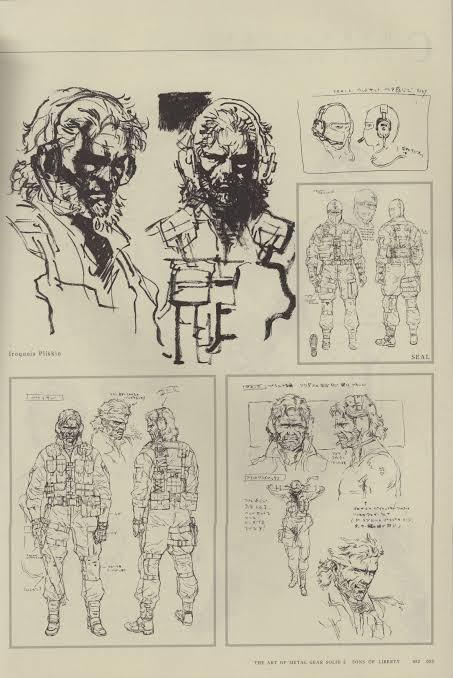

- The original game plan document, and a few of the trailers made to show staff and investors, actually call the game Metal Gear Solid 3 because they wanted to fuck with people even more
- Speaking of these internal trailers, there’s a few plot differences from the main game, such as Dead Cell being a Navy unit and the game taking place one day later then in canon
This behind the scenes disk also includes the full game script, all the cutscenes (without sound), and also a full section going over the actual coding of the game which I enjoyed massively but also understand a lot of players probably skipped over it, this might just be my interpretation but the way they handle Raiden unintentionally being a patriot agent reminds me of how they describe how the games AI work, which reflects the line of “A pawn can become a queen, but it is still just a playing piece”, Raiden was literally being treated like a game character from the start, he was never given a chance of getting on the same playing field as everyone else.
Not on the bonus disk, but the main disk of Substance also contains a skating mini game which has an awesome rock version of the main theme which I would recommend anyone unfamiliar with it to listen to right now.
8 notes
·
View notes
Text

#iswm#in space with markiplier#mgs2#metal gear solid 2#iswm spoilers#spoilers#no bc that's literally the premise. of both of them
49 notes
·
View notes
Text
liquid ocelot would do numbers with a certain mutual if he was in a different game
2 notes
·
View notes
Text
Do you know what day it is today?
That's right, April 30th.
youtube
HAPPY MGS2 DAY!!!
#mgs2 sons of liberty#mgs#mgs2 spoilers#mgs spoilers#mgs raiden#solidus snake#yeah i know the game came out on may 16 but shut up#let me have this#april 30th#april 30#Youtube
14 notes
·
View notes
Text
pokemon scarvi spoilers be warned but isnt it fucking crazy the ending has the same type of plot twist as mgs2
#guy whos only played mgs2 playing another video game: getting a lot of mgs2 vibes here#but seriously a major reveal where you figure out a prominent figure in the story was an ai along in a weird and offputting location. Crazy#the difference of course being the professor ai is not inherently malicious but the patriots from mgs2 definitely are#anyway this does mean arven is the raiden of pokemon now#pokemon scarlet and violet#pokemon spoilers#mgs2#judas.txt
4 notes
·
View notes
Text
Derealization in Night in the Woods and Metal Gear Solid 2
This post contains discussions and descriptions of severe dissociation that may be triggering to those who experience those symptoms and details themes of abuse, war and alcoholism please be kind to yourself when reading. Full game spoilers for NitW and MGS2.
In my Media, Myself and I series of posts I've been talking about depictions of Dissociative Identity Disorder in media. Highlighting good representation because I think it's easy to tear down what doesn't work, but showing what does is a very teachable moment. Best way to increase understanding and tear down stigma is to show understandable and relatable examples. Even if they're imperfect.
To that end, I wish to take a mild distraction from talking about identity focused symptoms of dissociative disorders and do some posts on elements of dissociation which aren't highlighted as often, particularly not well.
Depersonalization/Derealization Disorder is on the dissociative spectrum and the symptoms are experienced within forms of Post-Traumatic Stress Disorder and Dissociative Identity DIsorder.
To borrow an info-graphic I utilized in my Hypnosis and Dissociative Disorders essay a while back

Source: Mayo Clinic
The brain processes the world and our association within that connects the concepts of "Me" and the concept of "Reality" and integrates them so we are able to process external reality and express our internal reality.
When we look at our hand we can look at it and understand "this is my hand", the shape of it, the sensation of proprioception, the knowledge that we are able to move it and it will move based on our innate intention. There is no process of "I want to move my hand, I am going to move my hand, my hand is moving" it all happens as part of one seamless process.
A practice within hypnosis for creating a sense of dissociation required for trance states is to have a person look at their hand and turn the phrasing from "my hand" to "that hand". Gradually having a person look at a thing until our brains stop processing it in relation to our surroundings until it "detaches" as a way of temporarily removing critical filters in an effort to lead a person to an altered and suggestible state.
A good example of this one can experience without assistance is to stare into a mirror for an elongated period of time. Our brains are always attempting to process a large amount of information and presents context to you that changes "those images on the mirror's surface" into "my reflection", it's why we are able to feel familiarity as a sense. When we perceive something that activates those associations the relevant information automatically filters in our mind and presents the concepts associated with the stimulus.
If we stare at the same reflection for too long those associations begin to disintegrate and we begin to view them divorced of the contexts we hold for them.
For those who suffer dissociative disorders, this is the root of why someone with DID will not "recognize" their reflection or why a person may not feel familiarity with something/someone they are aware of.
Dissociative amnesia is a topic I wish to cover in a future essay but it is also included in this process. Essentially when we dissociate our minds lose the ability to effectively filter what we are perceiving and relate it to our selves, our memories and our experiences.
Derealization is what happens when that critical filter between the external world and our internal perception breaks down. It's when we are not processing the world as being something we are engaging with. This may present as a disconnection between our perception and our understanding, for example "my hand feels like it's larger than it looks" or it can be a complete disconnect from what is happening in your present reality causing you to feel like you are in a dream. In extreme cases you lose your ability to relate your actions from consequences.
Let me tell you, having this happen while you're behind the wheel of a moving vehicle is terrifying and I hope no one reading this ever has to experience that.
I should also note that these symptoms tend to get dramatically worse the more you focus on them. In my own life, if I have a sensation that parts of my body feel incompatible with my inner perception of them then the vague dysphoria can blossom into full dissociation if I try to examine the feeling in any depth.
For an everyday version of it, think about the sensation of Deja Vu and how it feels like you have already experienced something which is happening in the present. During that state you are dissociated enough from processing your present reality that it "feels" like you've already experienced it, despite the knowledge that you are currently in the moment.
All of this is to give a vague view of what Derealization is and what it feels like.
Today I want to share two pieces of media that include a character overtly experiencing these symptoms and how the fiction displays the character experiencing this internal experience so that an external audience may understand.

Night in the Woods is a 2017 narrative driven adventure game by Infinite Fall. It follows two weeks in the life of Mae Borowski, a 20 year old cat suffering from severe anxiety who has dropped out of college and returned to her childhood home, an impoverished Western Pennsylvania mining town named Possum Springs.
There she moves back in with her parents and reintegrates with the rural community of Possum Springs. She spends time with her childhood friends, talks to the locals and tries to solve the mystery of a severed arm found in town. All while having vivid dreams on a nightly basis and dealing with the an ambient level of judgment from her parents, friends and community over her perceived irresponsibility.
Where Mae is trying to solve the mystery of the severed arm and the secret cult that hides within Possum Springs, the audience has some other mysteries to solve attached to the attitudes of some of the residents. Mae's parents and friends constantly pressure her to explain why she felt it necessary to drop out of college when so much was sacrificed to get her there. There is also "The Incident", a mysterious event in Mae's past, ominously hinted at when Mae's next door neighbor warns...
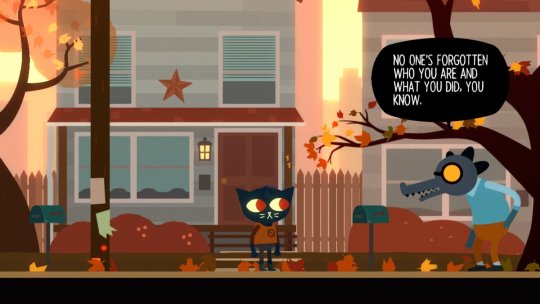
"No one's forgotten who you are and what you did, you know. Small town polite's all you got, kid."
The player is left in the dark as to the circumstances that paint Mae's reputation in town and throughout the course of the two weeks we begin understanding more about Mae's past, the circumstances behind her return to Possum Springs and the reasons those around her harbor a mild resentment towards her.
There are some potential supernatural elements relating to Mae's dreams and the nature of the cult but I feel it is best to stick to the grounded elements of the plot for the sake of this essay.
The Incident, it is revealed, is that 6 years before the game Mae beat another kid with a softball bat. Seemingly unprovoked. It earned her the nickname "Killer" and shaped much of the way people in the town, including Mae's own parents, view her.
"Why did you beat Andy Cullen?" and "Why did you drop out of school?" are questions people constantly demand of Mae and it forces her to become defensive and prickly to those around her. There's even a sequence involving a heated argument between Mae and her mother when the latter drops her kindness and patience over the matter and demands answers that Mae refuses to give.
To give the game away without fanfare, Mae suffers from extreme dissociation.
She's ashamed of it, afraid of it and the local town doctor, who I will discuss shortly, has no meaningful way of helping her deal with it. Mae is left to journal about her feelings with no meaningful way of understanding her symptoms or preventing them from crippling her. It is not even referred to as dissociation within the plot of the game, though those who are familiar with derealization will recognize it easily.
If you wish to see the conversation where Mae confesses her condition, it is about 4 minutes long and will provide some context, though I will brush over the description if you do not have time/ability to watch and listen.
youtube
Mae describes a time when she was playing videogames and felt an intense empathy towards the characters on screen. She felt like she knew them intimately and at a certain point something "broke", she came to understand that the characters she had been so connected with were not real. She was not actually connected with the events happening on screen, it was all a game.
And in understanding that she felt alone and abandoned on her side of the screen and the sensation spread out to the view outside of her window. The trees blowing by in the wind were as fake and distant as the characters in the video game. She had memories and attachments and associations with that tree, but looking at it from her window she could see that it was just a tree. Just an object.
"Just shapes"
This disconnect spread into every aspect of Mae's life and all of the associations she had built between herself and the world around her had vanished and she found herself in a world that she no longer felt attached to in any meaningful way.
"Just like this meaningless bulk of... stuff."
She felt alone. Abandoned. Overwhelmed by the simultaneous enormity and emptiness of everything.
The next day during the softball match she cannot even remember how it happened but she ended up ontop of the mass of shapes that was Andy Cullen and... that was The Incident.
Mae's family lost a lot of money paying off the medical debt for Cullen's family and everyone's attitudes towards her turned cold. She was sent to Dr. Hank for therapy... and this is where I take a break to discuss the causes of dissociative disorders and how badly Mae was let down.
The root causes of DPDR are the same as other dissociative disorders in that extreme abuse, neglect and continued stressful situations cause the mind to put up barriers and break associations to protect the self from harm. To boil a complex idea down to a few words consider the mind saying "This is not happening to me." as a way to prevent pain from an experience.
Where identity based dissociation focuses on the words "to me" and removes the self from the harmful events, derealization focuses on the words "this is not happening" and rejects the events outright, refusing to process the context behind what is happening.
Much of the game's story is told through implication and one must peel back layers in order to get a full story. At first glance Mae may seem like a normal young woman from a rural community in the rust-belt and question what could have been enough for her to develop a dissociative disorder.
First off, don't do that. No one owes anyone a justification for their condition and there is no such thing as "traumatic enough" to be valid for a diagnosis. What a person experiences is what they experience. But Mae is fictional and the core of her character is having an under-treated dissociative disorder. Half the reason I wanted to write this entry was because her depiction of it is deeply relatable and can be used well for teaching what goes into a person developing PTSD and dissociative disorders; most depictions seem content with sexual abuse or violent deaths.
For Mae, it's a lot more subtle and all too human. At least, for a cat in a world of anthropomorphic animals.
Mae's mother, Candy, never went to college and always regretted it. She feels like her life hit a dead end and she has remained in the mining town of Possum Springs decades after its mining industry faded out. She works as a receptionist at the local church, spends all day reading True Crime novels and had a number of miscarriages before finally giving birth to Mae, her "miracle baby".
Mae's father, Stan, was working with the mine when it closed down and has since been bouncing between job to job trying to keep his family afloat, especially after the medical expenses from The Incident, the subsequent remortgaging of the house and Candy's dreams of sending Mae to college. Stan tries to be a good father but hates his job, is always working and it is revealed he used to be an alcoholic.

Lastly you have Mae's Grandfather. He is dead before the game starts. Mae loved her granddad very much and his influence can be felt throughout the whole game. He would read to her, pay attention to her and teach her things. One of the game's DLC chapters even involves him reading Mae a bedtime story.
Also grandpa Borowski was a union man and collected the teeth of an employer who tried to abuse the workers. That doesn't really play in to my essay as Mae does not discover this fact until the events of the game but I am not going to go without hyping up a man for taking teeth.
Mae misses him so much that even 6 years after she was asked to keep a journal by Dr. Hank the first page reads "RIP Granddad" and as the game goes on the following can be found inside:

This information is drip fed to us through organic and relatable moments. For instance, Mae reveals her father's alcoholism while she is drinking too much (sidenote, she is underage for the location she lives) at a party.
The idea is to give a full and rich view of Mae's life and show that she may not even recognize the trauma for what it is and was.
For instance, we know from the start that Mae has crippling anxiety. This could easily be linked to the expectations of Candy putting her hopes and dreams of college on her "miracle baby". Before Mae was even born she had expectations placed upon her for being the long wanted child of a mother who wanted her baby to do all the things that she never could.
For neglect you have the fact that both parents are forced to work in abundance to maintain their lifestyle and pay for Mae's college in an economically depressed community. Mae spent a lot of her home life alone, feeling pressured by her mother and literally scared of her alcoholic father.
Both parents are good and loving and kind parents. But they failed in some regards. Sometimes you can want the best for someone you love and do everything you can to provide the best life and a failure to listen, adapt and accommodate can do more harm than anything.
Her grandfather eventually passed away, taking her positive links away in her home life and after The Incident she was ostracized from the community and forced into further isolation. Socially anxious, outcast and without her supportive grandfather, she eventually is given an opportunity to go to college. Something her childhood friend would have literally killed for an opportunity to do in her stead.
---and she drops out.
---and upon returning no one will get off of her case about it.

This damned statue did it.
A statue so loathesome to Mae that it appears in her nightmares and she relives the fantasy of smashing it to bits with a baseball bat.
If you watched the above video (or have played the game) you will know that the statue was made up of several shapes and was installed at Mae's college.
The sight of this statue terrified Mae to the point of which she would spend entire days holed up in her dorm room either not eating or gorging pizza and sleeping for days at a time.
Being away from the familiar sights and people of her home town made her dissociative symptoms go into overdrive. At home she knew that The Tree that had lost all meaning and association to her was still the tree that she played with when she was young. She knew that her parents are the people who raised her. Even when she saw them as "dead shapes" the memories persisted and she could endure.
At college it was nothing but strangers in a strange land and a statue comprised of shapes reminding her that everything was shapes.
But they sent her to therapy, did they not? Why wasn't she being treated?
Dr. Hank is a small-town doctor he is the physiologist, he is the dentist, he is the psychologist. He is the doctor. The only doctor and he has no idea how to treat someone with severe symptoms like Mae.
In town Mae can talk to a character named Selmers every day. Selmers is a self-styled poet with depression and also being seen by Dr. Hank. In discussing both mental healthcare treatment and depression with Selmers the player can learn that Dr. Hank treats all forms of mental illness the same. Essentially "journal until you feel better". The town lacks the structure and framework to provide help to someone like Mae.
In other words she has been untreated this entire time and removed from her support network and sent off to college, she could not handle things. Of course she was going to fail under those circumstances.
The game does a remarkably good job of displaying how DPDR can impact a person, especially as it is linked to anxiety and depression, and creates an empathetic narrative about what it must be like to live with that condition.
Sadly it offers little in the way of answers for treatment. In reality treatment involves psychotherapy and creating a structure of coping mechanisms for how to handle episodes and ground oneself. This can come in the shape of breathing exercises, kinesthetic sensation fixation, identification exercises ("name all of the blue items you can see" "name all of the items that begin in A") but above all else, getting a grip on what emotional triggers one has and learning to resolve them will help.
For Mae, being away from home is a trigger for her. Home isn't going to be the same place and people forever. She needs to be able to get on top of her symptoms in order to cope. Dr. Hank was not helping her with that.
The game ends on a bittersweet note that Mae may end up spending her whole life in Possum Springs purely from fear of leaving her zone of familiarity.
Unfortunately the narrative is about clinging to a dying town and how unsustainable it is.
We do not know what will happen next. The structure that failed Mae has only gotten worse in the 2 years since she left for college. Her parents may end up selling the house because they cannot keep up on the payments and on a long enough timeline Gregg and Angus will move away (should their relationship survive the effort to escape) leaving Bea and Mae to watch Possum Springs continue to decay.
Part of Mae's journey is accepting this inevitability and not fighting it, but choosing not to abandon the town regardless. After all, she can't stray from it without a risk to her mental health.
The game offers no answers. It simply shows a slice of hard reality for those who live caught in the trap of decaying towns, economic collapse and mental illness without support structures and treatment. but it does a very good job of providing an empathetic case that an audience can relate to and sympathize with the symptoms of.
But what about a game that tries to make the audience feel the same way that the character does...?
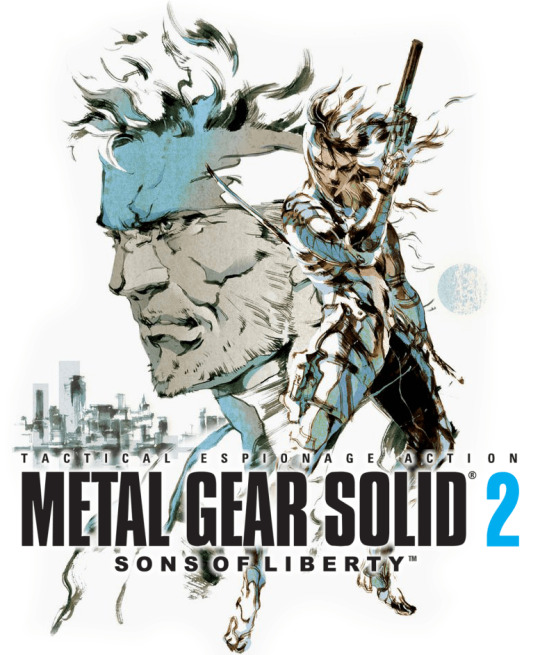
Metal Gear Solid 2 is a 2001 self-proclaimed tactical espionage action game developed by Konami.
It tells the story of a secret military operations agent code named Raiden who is attempting to save the US President from a terrorist group called Dead Cell. There is much more to it. But I am attempting to be brief.
Metal Gear is absolutely frustrating for me to write about in this essay series because their research tends to be fairly good but their sensitivity often comes off as actively malicious at best.
In terms of conditions, symptoms and sensitivity to emotional triggers, Raiden is on paper a fairly decent representation of dissociative disorders developing in those who grew up in war. In practice he has a murder alter named Jack The Ripper who breakdances with 3 katanas.
I promised I would stick to positive depictions only and so I will stick only to the final 2 hours of Raiden's first appearance.
At this point in the game the president is dead, we have learned that the terrorists were really after a giant battleship that houses a powerful AI which is going to be used to censor the internet to control the flow of information and control the populace. Raiden has met up with protagonist of the first Metal Gear games, Solid Snake, and has managed to install a virus into the AI system that will corrupt the data and prevent it from controlling the internet.
In order to get on the battleship, Snake betrays Raiden and hands him over to the terrorists.
Thus begins the final act of MGS2.
It is imperative to understand that these events happen in rapid succession right after the AI is infected with a virus.
Neither the audience nor Raiden are given an opportunity to truly process all of the rapid fire information that we are hit with.
MGS2 has a metatextual narrative about the nature of sequels and audience expectations. Many of the events happening within the story are intimately playing upon our familiarity with the series, recreating circumstances from both Metal Gear 2 and Metal Gear Solid. Part of the critique is that players are looking to simply recreate the experience of the first game and the narrative goes out of its way to punish Raiden (and thusly the player) for trying to "be" Solid Snake. Much of the game has been mired in failure and any wins we have received are either negated in a cutscene following our gameplay victory or are displayed as being ineffective next to Solid Snake who is forever being displayed as the better protagonist.
So when Raiden wakes up in a torture chamber directly designed to look just like the Shadow Moses Island torture chamber from Metal Gear Solid 1 (and both dialogue and graphics of that cutscene are displayed briefly) we, the player instantly assume familiarity with the concept. To drive that point home the player is forced to survive a button tapping mini-game which is sprung upon us out of nowhere (there is no tutorial. The game expects your familiarity with the concept and thusly does not need to explain it - as a side note it is impossible to die in this minigame, so a lack of familiarity does not impact gameplay, only narrative experience)
All while the only surviving villain from the first game directly says in dialogue "We're also inside the memory of Shadow Moses"

The cutscene also has Raiden face to face with the main villain who recognizes Raiden as a child soldier he helped raise to fight in an African conflict. For the first time we are able to view Raiden, view Jack as his own man outside of his similarities to Solid Snake. We find out he is a child soldier with an impressive kill record who was raised with other child soldiers, drugged and forced to kill in a conflict that he had no personal connections to. He claims "I was given a gun and told to shoot, if I refused then I was the one who would be shot."
Throughout the game, Raiden has been getting phone calls from his girlfriend, Rose, who serves as the mission analyst. When the villain, Solidus, reveals Jack's history she calls him to ask more about this and Jack at first pushes away the memories, claiming that "they" wiped his memories and that he experiences nightmares only to give a vivid and emotionally description of his experiences as young as 6 years old killing for no reason other than he was told to.
Rose attempts to comfort him, to say that she wants to share the burden of his past, Raiden refuses, blocking everything out and pushing Rose away, claiming that he cannot afford to start a family.
Children are a huge emotional trigger for Raiden. This is displayed heavily in the future games of the series.
Overall this is an extreme example of a backstory that would give an adult severe PTSD and forced to confront his past, Raiden is emotionally primed to have a complete dissociative break from reality.
But presently I am not writing about how Raiden experiences derealization. I'm writing about how the player experiences it.
We know that Raiden has been trained in virtual reality to prepare him for this mission. When we see cutscenes describing this we are shown footage of the previous Metal Gear games, particularly the virtual reality training missions from the PS1 game.
The implication is very much that Raiden has played the same games that we ourselves have. The Metal Gear Franchise has an interesting meta-narrative going on that displays games are released in order of declassification with an early conversation in MGS4 mentioning that the events of MGS3 (which takes place in 1964) were declassified recently in the game's present of 2014.
Raiden has played the Metal Gear games. We have played the Metal Gear games.
And the game itself is overtly recycling moments from earlier entries of the series and trying to highlight this fact.
Right after we put a virus into the AI.
Things got really weird from the moment we insert the disc to infect the system.
Escaping from the torture chamber our character is completely naked and runs to the next area. We are given a loading screen.

Ominous music plays and we receive a phone call from Campbell, the mission control from both this game and the previous Metal Gear games. He speaks with a distorted voice. He stutters, telling you that you must proceed with your m-mission. He notes that in your current condition you will not be able to attack or "enter the hanging mode"
He continuously spouts the mission objective and says your role is to take out the terrorists. Raiden demands to know why he keeps saying "role" and Campbell replies
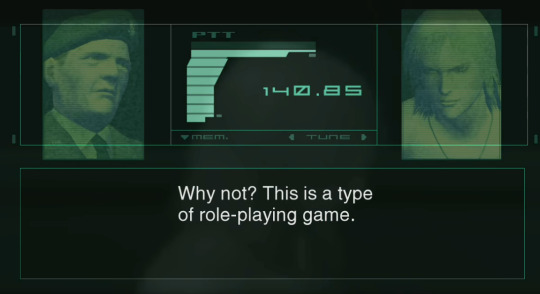
Raiden then notes that he has never met Campbell in person. He has only spoken to him over long distance communication.
Should you return to the torture room the title card will be switched with the name of Japanese rail stations. If you pause the game you are treated to a "map" of Arsenal Gear:

The image is from Glauben, Wissen und Kunst der alten Hindus
All while Campbell calls you every few steps to order you to turn the game console off, recycle further lines from previous Metal Gear games (as well as show footage from them) and your radar is replaced with voyeuristic footage of a young woman sunbathing.
The enemies are now wearing thick armor with no humanizing characteristics and they fly about with inhuman power while wielding katana that can block machine-gun fire.
The floor has scrolling text floating across the surfaces something that the series uses for the VR stages to signify you are in a training stage.
The game is pulling out all of the stops to make sure you are confronted with the reality that you are playing a video game while the character within the video game is experiencing the same information.
He meets up with Snake who reveals he has the unlimited ammo bandana from completing MGS1, all but confirming this is a video game. Much of the information in this segment can be justified in-game. I literally cannot sidestep the fact that a flesh and blood man pointed at a piece of headgear and said "Unlimited ammo". I almost wanted to skip over it as it's devastating to my point about how the game tries to pull you and Raiden out of reality.
See to Raiden, he can no longer be certain if any of this is happening or not because of his experiences with VR. With everything collapsing around him, it feels reasonable to assume that the AI Virus is breaking down the universe around him. With full knowledge of the plot, we the audience can know that everything is happening and the virus has infected his augmented reality elements that make up the in-game HUD. But Raiden doesn't know that and the player on first playthrough cannot fully know it either.
It's almost reasonable to assume that the entire game is taking place within a VR Simulation.
Virtual Reality has long been studied as having links to DPDR with a number of scientific studies examining the link.
The connection is very much there though typically VR only influences a mild sensation of derealization when playing, though to those prone to dissociation they may experience more rapid and powerful effects with prolonged exposure.
Raiden tells Snake what is happening and how his grip on reality is falling apart, going as far to doubt whether his girlfriend, Rose, was ever real either. Snake has no idea how to verify for Raiden that the things that are happening are real and tells him to just keep moving forward and figure it out. He also provides Raiden with a sword.
In the metatext, this is a symbol for Raiden gaining his own unique playstyle. As long as he is emulating Solid Snake he cannot succeed but when he accepts himself as his own person and embraces his unique gameplay mechanic he is able to break free from the narrative and actualize as his own person.
In the sense of the derealization episode, it gives Raiden an opportunity to mow down the wave after wave of "Tengu Soldiers" who come after him and Snake.
Metal Gear is a franchise that doesn't like it when you kill people. Here it has handed you a sword and told you to go to town with an unlimited supply of anime ninjas. The game lightly insisting "it's a video game, it makes no difference how many people you kill" and to flaw the game's philosophy for a moment, the only penalty is a ranking when you beat the game. MGS3 is the one that actually hits you with consequences for in-game murder.
As Raiden stands on a platform with Snake the game continues to devolve and a custom Mission Failed screen appears, mimicking the standard game over.
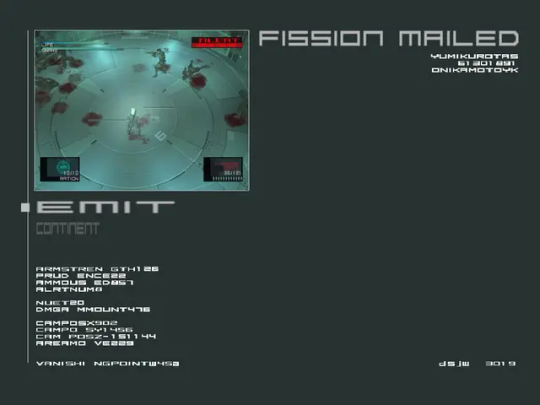
Gameplay continues inside the small box that typically displays where you died, you can die on this screen.
You then fight 25 copies of the giant mech in a recreation of the photo area from the Metal Gear VR Missions and the world's most convoluted plot reaches its crescendo point with every character betraying everyone else before Raiden has to kill a cybernetic US politician with a sword for the first but not last time.
The sequence takes about forty-five minutes to an hour thirty depending on your play style. The plot is too much and has a layer of metatext on top of it regarding the nature of audience expectations and sequels along with a haunting premonition of what the internet would become.
There are a lot of reasons to praise and a lot of reasons to hate the ending of MGS2. Personally I adore it. But one thing that truly cannot be stated enough, especially back in 2001, is how the game intended to make the player feel during that final section.
It's not enough that Raiden was having a complete dissociative episode, losing grip on his reality, it's that the game was designed to make the player go through those emotions at the same time as the character.
I was going through a really rough patch at the time. It was a few months before I was kicked out, my ties with my mother had been cut off, my dad was in a ward and suffice to say where my head was at the time? The immersive dissociative experience this game offered worked like a charm. Though external factors had a lot of influence.
DPDR is weird in the sense that everyone dissociates. It's a natural and normal thing, but disorders that are born from an excessive amount of disconnect between the self and reality tend not to be relatable experiences. Displaying a character losing their grip on reality is not an easy thing to do.
When we see someone say "I don't know what's real any more" in a piece of media we have empathy for their situation but it's not easy to have the audience in the same mindset as them.
Another hauntingly good example is Perfect Blue which I will likely not discuss in detail in this essay series because the content is a little too dark and the depiction of Dissociative Identity Disorder is not flattering in the slightest.
But the movie does depict an actress whose reality is blurring in with fiction by having a series of interactions happen one after another and revealing that the entire scene was part of a television shoot, with every subsequent scene piling on the confusion between what is happening on camera and off camera.
I can think of other examples of characters experiencing derealization episodes. Some even have fairly good depictions of how someone can be driven to that point, such as the slowburn of Bojack Horseman Season 5 where a number of circumstances pile on until the title character has an episode. The problem is... every single depiction that is coming to mind right now ends in either stigmatizing depictions or violent outcomes.
Heck, even Mae and Raiden up there had violence attached to their dissociation.
If there's one thing I want to make clear as I go through these essays, it's that those who have mental illnesses featuring dissociation are usually trauma survivors and are far more likely to be the victim of violence than the perpetrators of it.
I'm happy with the two examples of derealization I've written about today, NitW for the realistic depiction of the origins and impact and MGS2 for taking the player along for the ride; but I'd still love to see an example where a break from reality did not end with blood.
Please send me an Ask if you can recommend any.
-
So... that about brings it to a close for my little ramble on DPDR. I've a few other entries in the essay series on the back-burner. Next will likely be a breakdown on how Umineko handles recontextualizing memories. I've gotten a few paragraphs of that drafted out already.
These essays are really a bit of self-indulgence for me, though so they happen when they happen.
Thank you for reading.
#dawn posting#night in the woods#nitw#metal gear#mgs#mae borowski#raiden#media myself and I#what a thrill#DID#watch me post my trauma in public#derealization#DPDR#unreality#media essays#Youtube
36 notes
·
View notes